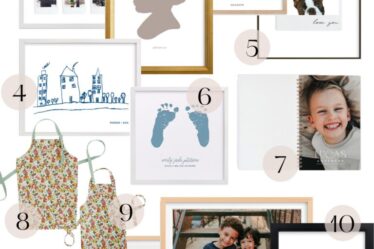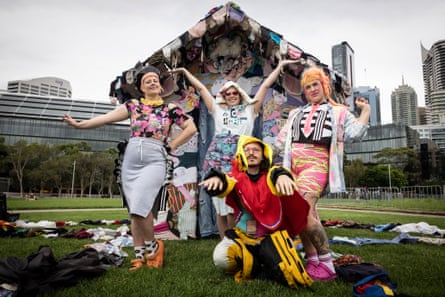
Over the weekend, a shed draped in 250 kilograms of clothing waste was constructed in Sydney’s Tumbalong Park, in the busy tourist precinct of Darling Harbour. Its walls were covered in T-shirts and singlets. Underwear and bras hung from the roof. Four pairs of jeans dangled in the doorway.
The House of Fast Fashun [sic], created by a Melbourne-based art collective of the same name, was the backdrop for a two-day series of workshops and runway shows, held as part of Sydney festival. Another 750kg of used, damaged clothes was scattered in large piles on the lawn surrounding the house.
Fast Fashun comprises Sebastian Berto, Luna Aquatica, Sarah Seahorse and Teneille Clerke (AKA Tenfingerz). They invite members of the public to create outfits from waste and wear them in runway shows. At the Sydney festival event, these were staged on the hour.
“There’s so much fashion waste in the world and it’s such a massive problem,” Berto says. “When you create something out of trash, your sense of value for the fabrics and things that you’re using changes when you wear it.”
The exhibition featured one tonne of textile waste in total. Just a fraction of the 227,000 tonnes of textile waste Australians send to landfill every year. An additional 190,000 tonnes is donated to charity, but over half of this is exported to countries in the Middle East and Asia.
People of all ages, ranging from small children to grandparents, clambered over and rummaged through the piles on the first day of the exhibition, pulling out everything from doonas and curtains to fur stoles and hats. There were several sewing machines set up on trestle tables around the park. Parents helped kids piece together outfits, offering words of gentle encouragement. Repair and hand-making skills were on proud display. Scissors were taken to garments. Hems were sewn. Fabric was tucked, pinned and tied. The pace picked up when Tenfingerz announced there were just 15 minutes left until the first runway show.
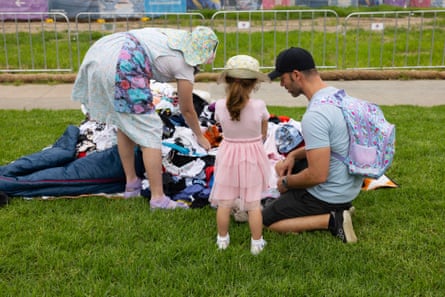
Then, participants were ushered inside the house where dance music played loudly. Brendan de la Hay opened the runway show, popping out from between the jeans-door wearing a pink pattern sheet, ruched up and turned into a poncho. It was a display of joy that set the tone for every outfit that followed. De la Hay threw an enormous piece of white tulle, that doubled as both veil and cape on top of their ensemble. It came off with a flourish at the end of the catwalk.
De la Hay is a designer and stylist by trade. It was their first experience with House of Fast Fashun, but it won’t be their last. “I love working with recycled products,” De la Hay says. “It’s so fun to see the community getting involved and super fun to walk.”
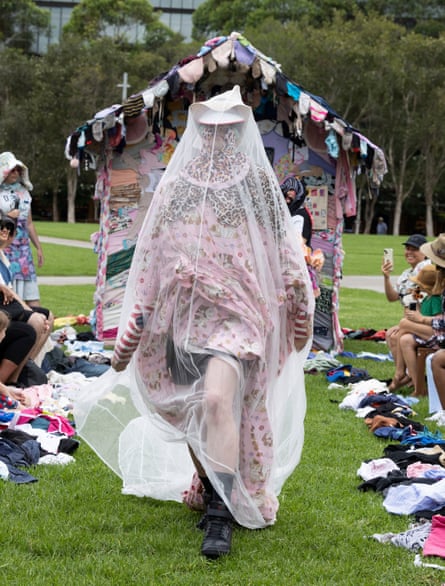
As the next participant came down the runway in a sheer curtain expertly fashioned into a gown, Tenfingerz told the crowd to clap and cheer “any time anyone does anything”.
The collective staged their first runway show in 2012, in a warehouse in Melbourne’s Brunswick, but it wasn’t until 2019 that they made fashion’s inherent excess the focus of their events. They procured clothing waste from charities, asking only for products too damaged to sell. The Sydney festival event was supported by Vinnies, while in Melbourne they work with clothing recyclers Upparel. After each show, the clothes that haven’t been rescued by attenders are dropped off to the tip.
after newsletter promotion
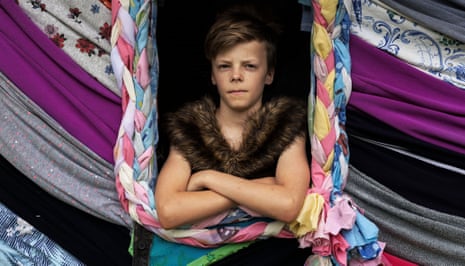
“We learned when we did the first one how powerful it is for people to get hands-on with the waste and to see the scale of it,” Tenfingerz says.
Lenka, who walked with her son Quinn in the runway show, found it alarming to see the volume of perfectly good clothing getting thrown away. “There’s a lot of good stuff here. Beautiful stuff,” she says. “It’s a really great initiative, to be just coming face to face with that and thinking creatively about what we put on our bodies.”
A percentage of the clothes were pilled, stained or torn, but some were just a little worn and in otherwise good condition. The brands on the tags were familiar: Shein, MJ Bale, Bonds, Arthur Galan, Peter Alexander and YD.
Although raising people’s awareness of waste and the dangers of consumerism is one focus, for the artists, the takeaways from the exhibition shift and change all the time. It’s important that the experience of Fast Fashun is fun, empowering and engaging. “Often people just come to watch, and they’ll watch one runway show and be like, oh my God, I can put a shoe on my head and they’ll be in the next one,” Tenfingerz says.
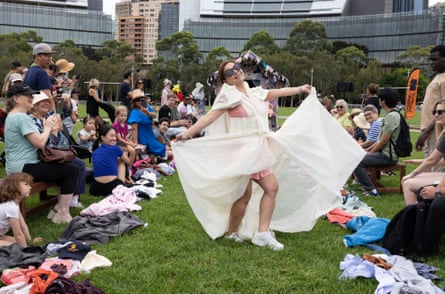
Giving people confidence is key to undoing some of the social conditioning that drives consumers to wear the latest trends, they say.
“It might feel frivolous with the state of the world to be playing and doing silly stuff with fashion,” Seahorse says. “But actually, it’s really important for people to realise that you can talk to strangers. You can meet new people. You can have discussions about fashion and waste.”

